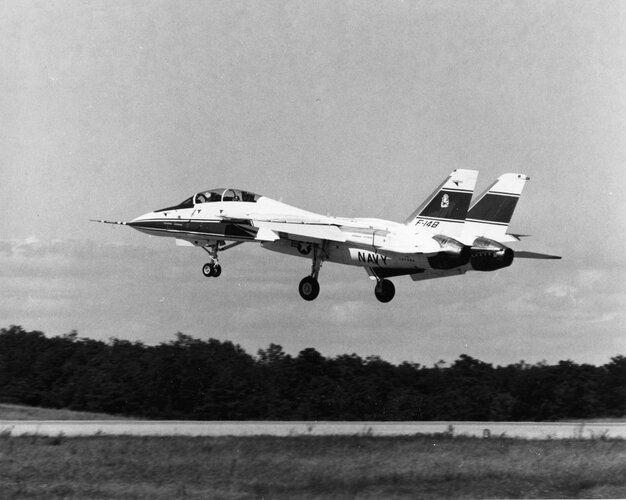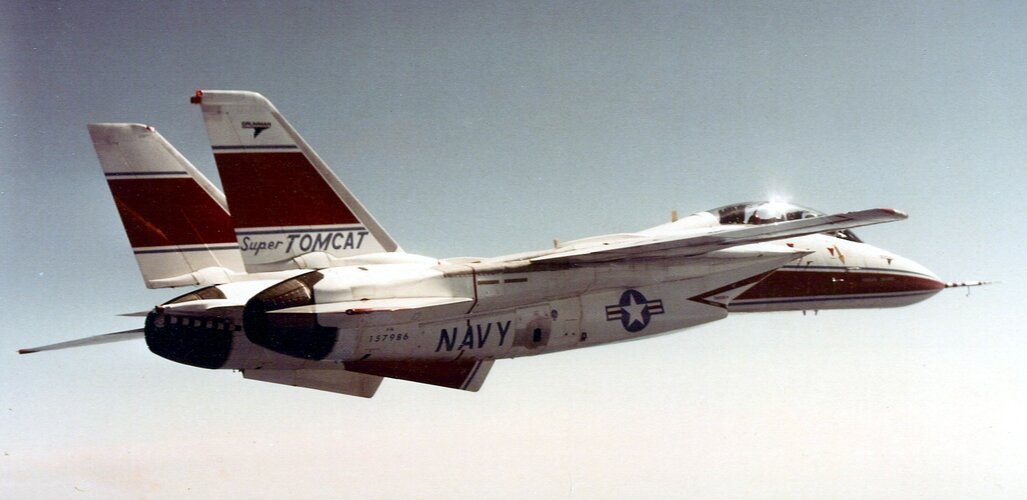Bruno Anthony
I miss the Cold War
- Joined
- 5 August 2012
- Messages
- 627
- Reaction score
- 600
Can anyone post whatever they have on the P&W F401-100 engine for the F-14 and if possible how it compared with the GE F110 that actually went into the F-14D?
Bruno Anthony said:Can anyone post whatever they have on the P&W F401-100 engine for the F-14 and if possible how it compared with the GE F110 that actually went into the F-14D?
Bruno Anthony said:Nobody has info on the f401or how it compares with the F110? On this website?! Come on now don't be shy!
Bruno Anthony said:Nobody has info on the f401or how it compares with the F110? On this website?! Come on now don't be shy!
The F110 has a higher BPR than the F100PaulMM (Overscan) said:I can post something later but effectively it had the same compressor but larger fan, bypass ducts and afterburners so a higher bypass ratio which increased thrust, especially in afterburner, and decreased SFC in cruise, at a cost in high speed performance and weight. This is quite different from the F110 which has a lower bypass ratio than the F100 I believe.
PaulMM (Overscan) said:Higher thrust in afterburner is typical of higher bypass ratio turbofans due to the additional unburnt oxygen available in the bypass air. You can chuck extra fuel in due to the greater oxygen content, giving more thust. It will come at a cost of higher afterburning SFC.
F110 would burn 20% more fuel than F401 in cruise or military power (military SFC ~0.75 versus 0.62) but less 26% less fuel in afterburner (2.01 versus ~2.55).
F110 also had a slightly lower pressure ratio than the F100/F401 (which were excessively ambitious in this regard and which contributed to their issues) but was less sensitive to disturbed airflow and perhaps more reliable.
There was no "magic" in the F401 engine configuration just a different balance of capabilities.
Steve Pace said:wasn't this engine employed by the Rockwell XFV-12
Not in terms of thrust, but definitely yes in terms of range. It looks like the F401 would give a longer loiter time on station for CAPs, and longer range in general, but a shorter range on a supersonic deck launched intercept. So it would make the F-14 a better missileer, but it would burn through fuel faster in a dogfight or on an intercept mission.PaulMM (Overscan) said:Higher thrust in afterburner is typical of higher bypass ratio turbofans due to the additional unburnt oxygen available in the bypass air. You can chuck extra fuel in due to the greater oxygen content, giving more thust. It will come at a cost of higher afterburning SFC.
F110 would burn 20% more fuel than F401 in cruise or military power (military SFC ~0.75 versus 0.62) but less 26% less fuel in afterburner (2.01 versus ~2.55).
F110 also had a slightly lower pressure ratio than the F100/F401 (which were excessively ambitious in this regard and which contributed to their issues) but was less sensitive to disturbed airflow and perhaps more reliable.
There was no "magic" in the F401 engine configuration just a different balance of capabilities.
So perhaps no significant difference in Tomcat performance with either engine? Assuming the F401 came through on it's promise.
AIUI, Pratt & Whitney were struggling to get the core to pass a 150-hour endurance test as normally required. The USAF, needing the engine to make the F-15 viable, decided they'd accept the engine if it could pass a 60-hour endurance test. Which it could.The problem was that Air Force was reportedly cooking the books on results from testing of the F100, which was the basis for the joint development program of the core, because without it they had no F-15. As a result, the Navy would have to pay a significantly higher price to get reliability of the F401 where they needed it to be. The Navy decided that was unaffordable, and decided to stay with theTF30 was never meant to be the production engine for the F-14, but at least was flying in the aircraft.
AIUI, Pratt & Whitney were struggling to get the core to pass a 150-hour endurance test as normally required. The USAF, needing the engine to make the F-15 viable, decided they'd accept the engine if it could pass a 60-hour endurance test. Which it could.The problem was that Air Force was reportedly cooking the books on results from testing of the F100, which was the basis for the joint development program of the core, because without it they had no F-15. As a result, the Navy would have to pay a significantly higher price to get reliability of the F401 where they needed it to be. The Navy decided that was unaffordable, and decided to stay with theTF30 was never meant to be the production engine for the F-14, but at least was flying in the aircraft.
Once the Air Force had accepted the engine, they (apparently successfully) argued that the 50/50 joint development agreement had been met. Any further work to meet the Navy's requirements - including the 150-hour endurance test - had to be paid solely by the Navy, which made the project unaffordable.
As well as the F-14B, there was also a study of putting an F401 into an A-7, which would have created something similar to the A-7F. Doing something similar with the F-111 seems like an obvious upgrade, though given that it was a Navy engine I doubt if it was ever really looked at.
As well as the F-14B, there was also a study of putting an F401 into an A-7, which would have created something similar to the A-7F. Doing something similar with the F-111 seems like an obvious upgrade, though given that it was a Navy engine I doubt if it was ever really looked at.
Given that they wound up experiencing reliability issues in service and funding the -220 engine later anyway, it probably would have made sense to continue development. Presumably a notional '-120' version could have entered service significantly earlier than 1986.I get the USAF willing to accept the reduced 60 hour endurance test so they can get more F-15s in the air but why would they abandon further development? Besides for better reliability more thrust could definitely be possible later as future variants of the F100 would prove. They just didn't want (or couldn't) pay for it?
Don't you ever underestimate the Air Force hate for other, rival services.I doubt screwing the USN over was the justification for stopping work
Oh you sweet summer child. You're talking about the same service that strenuously argued that Naval Aviation should be totally disbanded after WWII. The same service that was so vehemently opposed to Naval Aviation that they managed to get an entire class of aircraft carriers canceled after the first ship had already been laid down. The same service that came within a hairsbreadth of killing all Naval Aviation in only the 3 years since they were formed and the outbreak of the Korean War. Screwing over the Navy is the main goal of the Air Force.I doubt screwing the USN over was the justification for stopping work - budgets are a more likely explanation.


Oh you sweet summer child. You're talking about the same service that strenuously argued that Naval Aviation should be totally disbanded after WWII. The same service that was so vehemently opposed to Naval Aviation that they managed to get an entire class of aircraft carriers canceled after the first ship had already been laid down. The same service that came within a hairsbreadth of killing all Naval Aviation in only the 3 years since they were formed and the outbreak of the Korean War. Screwing over the Navy is the main goal of the Air Force.I doubt screwing the USN over was the justification for stopping work - budgets are a more likely explanation.
